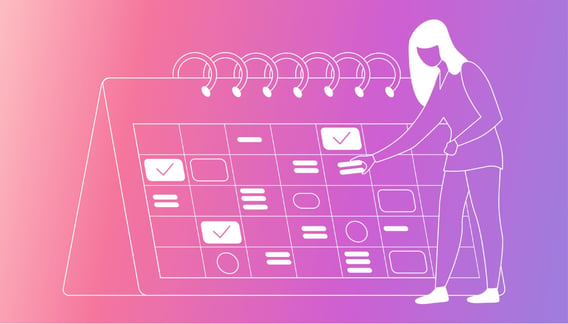We all get swamped by our daily tasks and commitments from time to time. When this happens, our personal and professional lives feel the effects, which can include burnout, inefficiency, and excessive stress.
But highly productive people have a secret that helps them organize their day-by-day plan: a daily schedule.
And while a daily schedule is a simple concept, it’s important to execute yours with wisdom and know-how to experience its full benefits. Our article will teach you how to do this.
What’s the difference between a schedule and a routine?
While often used interchangeably, daily routines and schedules are distinct from one another.
A routine is a sequence of regularly followed actions, such as always starting the day with coffee and catching up on the news.
A schedule, on the other hand, is a timed plan for carrying out a process or procedure. For example, 8 a.m. is coffee/news, 9 a.m. is catching up on emails, and 10 a.m. is the first meeting.
While a routine is a habit or pattern we embed in our daily lives, a schedule has a bigger intent to it — it breathes life into your routine and works via a specific timeline to help you accomplish your goals or workload.
Benefits of a daily schedule
A well-organized daily schedule can revolutionize your work and personal life. Here are the benefits you can reap from having a structured day:
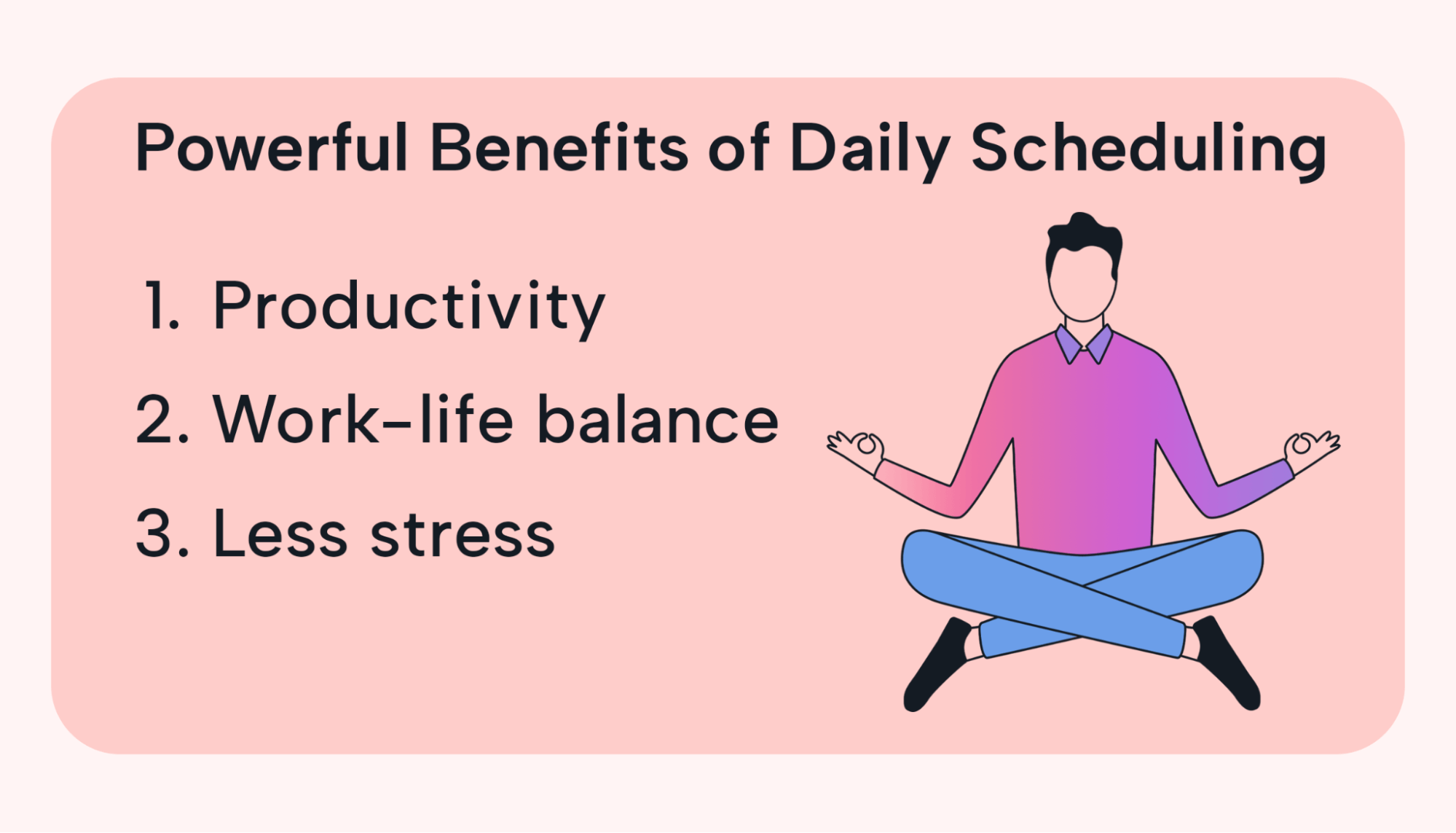 |
Increased productivity
Planning helps prevent you from aimlessly wandering in a sea of tasks.
When you know what’s next, you can transition easily, making use of every minute you have. You are also less likely to switch to a different task early because you’re carrying out an intentional plan.
Our brains have only so much bandwidth. Stopping throughout the day to decide on your next move chews up that mental energy and can lead to fatigue.
Having a set plan frees up your mind to focus on completing your work.
Better work-life balance
Boundaries help prevent burnout, and they’re exactly what a schedule gives you.
When you work continuous, poorly defined hours, overworking can result — and this can affect your personal life.
Unfortunately, this situation is all too common. A 2022 Gallup poll found that almost 30% of employees are always or often burned out at work. Fortunately, by scheduling breaks and establishing clear end times for them, you can get the rest and personal time you need.
Also, with a schedule comes the psychological benefit of closing out the day. The day feels like a success as a result, and you can approach the next one with a renewed mind.
Reduced stress
A scheduled day also offers predictability, which can help mitigate stress. Just knowing what lies ahead cuts down on the overthinking that stems from uncertainty.
Gallup’s 2023 report on the global workforce found record-high levels of employee stress.
This indicates it’s more important than ever that employees get the clarity and sense of control that a schedule provides.
The role of balance in scheduling
Being organized in your daily schedule can bring about many rewards. However, balance is an essential component of creating a schedule that works.
Let’s now discuss how to maintain that balance.
Prioritize what matters
We all have a lot to do. But not all of it matters in the grand scheme of things. Identify your “Big Rocks” — those major tasks or goals that are essential to you.
Knowing your priorities will help ensure you don’t let less important tasks overshadow what really counts.
The Eisenhower Matrix offers another strategic approach to making a daily schedule. It’s a way of categorizing tasks based on their urgency and importance.
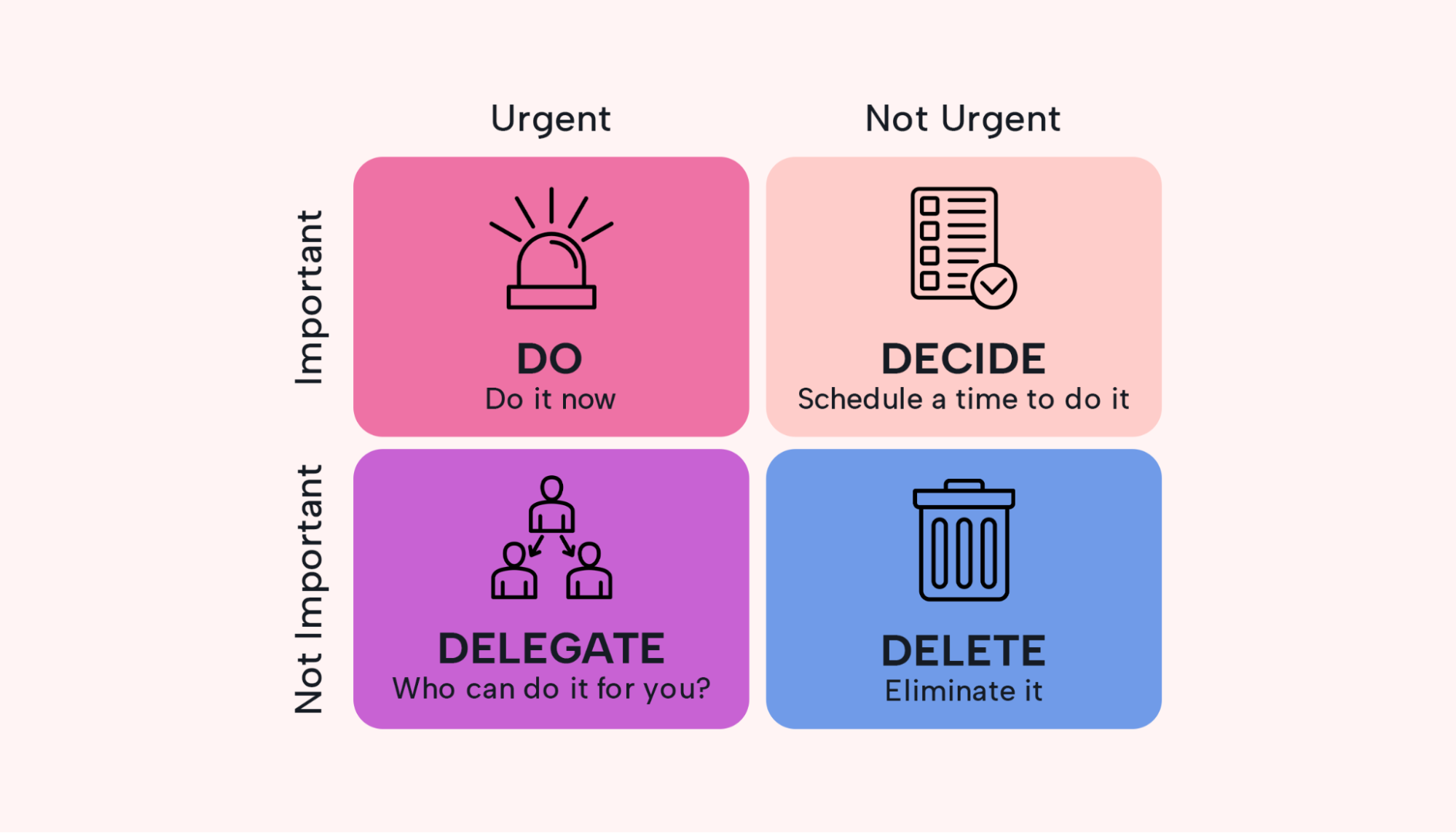 |
This system helps you align your tasks with your daily goals or values. A balanced schedule isn’t just about what we add but also what we decide to leave out.
The art of rest
The idea of 24/7 productivity is just that — an idea.
Scheduled downtime is a necessity for both the mind and body. And, just like with work, when we schedule rest, we make sure it happens.
Taking breaks can recharge us, making future work more effective.
Not everyone is a morning person or a night owl. Understanding your own rhythm can help you schedule these breaks. Set rest periods to occur during times when your energy naturally dips.
Personal vs. professional time
A related point is respecting the boundaries between work and personal time. Avoid the trap of always being “on” or accessible. Be sure your personal time is respected and preserved.
As we work more from home and build deeper digital connections, the line is harder to draw between our professional and personal lives. Technology can help create these problems, but it can also solve them.
Here are some tips for protecting your personal time:
- Use specific apps to segregate tasks
- Designate different devices for work and leisure
- Create distinct spaces at home for work and relaxation
A step-by-step guide to the perfect daily schedule
Crafting the ideal daily schedule isn’t about filling every minute. It’s about optimizing each hour for purpose and productivity.
Let’s go through this process.
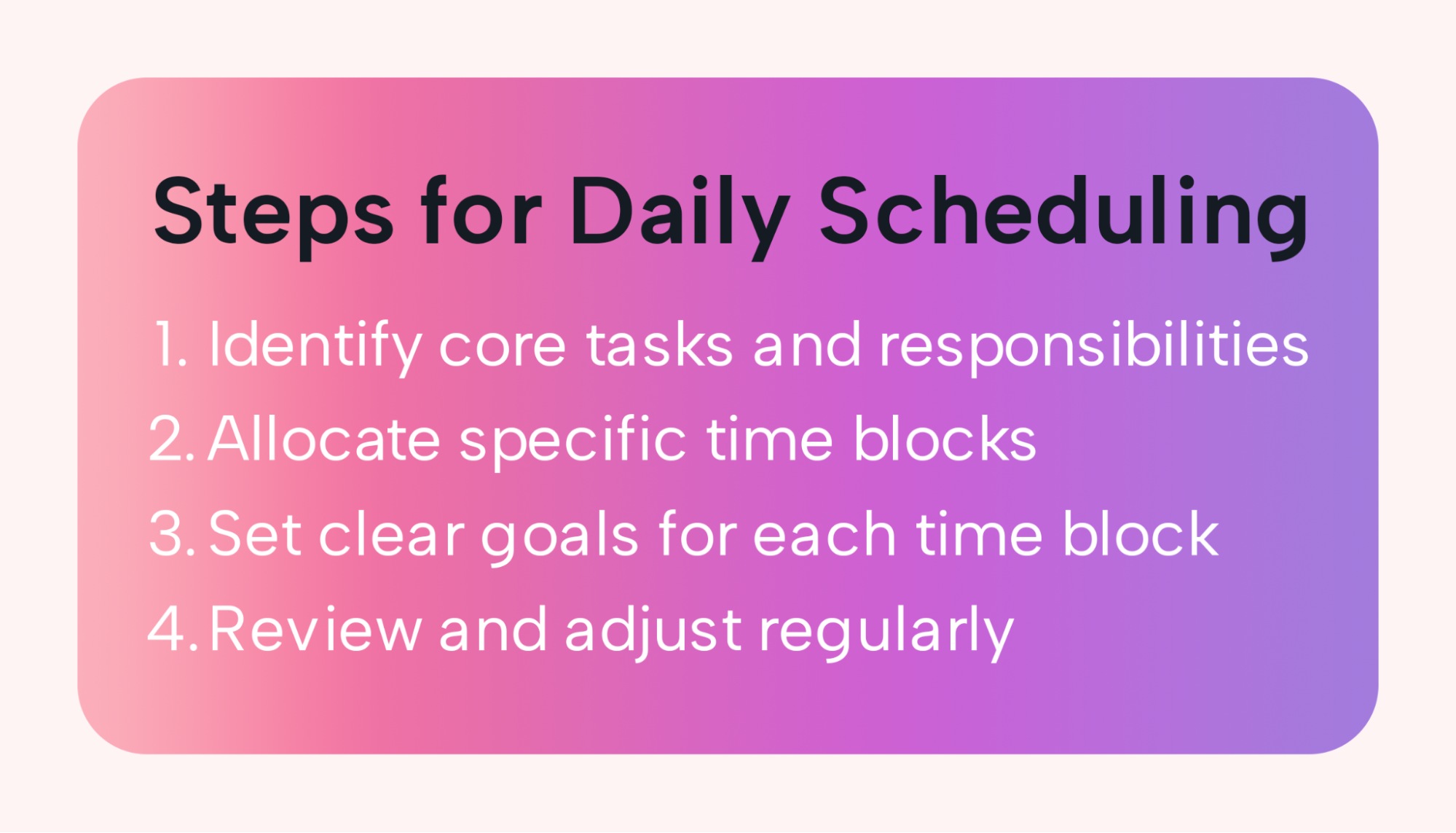 |
Step 1: Identify core tasks and responsibilities
Every great schedule begins with understanding what’s essential.
Start with the non-negotiables — those meetings, recurring duties, or tasks that have hard deadlines.
Knowing what consistently demands your time each day provides a foundation to work with. As you outline these tasks, consider your own productivity and rhythm.
We all have times of day when we feel most alert and energetic. It’s wise to schedule more complex or demanding tasks during these peak hours of productivity. Save tasks that are more routine for times when your productivity is naturally lower.
Step 2: Allocate specific time blocks
With your core tasks identified, it’s time to organize your day.
Time blocking is a powerful technique for organization. It involves dedicating chunks of time to particular activities, such as the following:
- Periods for focused work
- Brainstorming sessions
- Meeting with clients
- Breaks
Each of these is given a specific amount of time on your schedule.
The key here isn’t just to schedule work but also to ensure a balance between work, relaxation, and personal time.
Each block of time should have a defined beginning and end to help maintain boundaries and discipline.
However, be cautious about scheduling tasks back-to-back. It’s better to have buffer periods between them. These moments act as cushions for transitions or when a task unexpectedly takes longer to complete.
Step 3: Set clear goals for each time block
Knowing what you’re doing is one thing. Understanding why is another.
Rather than having a vague idea of what needs to be done, define what the successful completion of that time would be.
For instance, don’t just schedule time to “work on Project A.” Give yourself a goal. Maybe your aim is to “complete the project draft.”
This approach not only provides clarity but also gives a much-needed sense of accomplishment.
If you’re facing a bigger task that seems daunting, break it down. Doing this will make it more manageable and keep the motivation rolling.
Step 4: Review and adjust regularly
No matter how well you plan, there’s always room for improvement.
 |
Incorporate regular reviews into your routine. Whether they’re weekly or bi-weekly, take a moment to reflect on what worked well and what didn’t.
Ask yourself:
- What went smoothly?
- What felt rushed?
- What tasks were continually pushed to the next day?
These reflections will guide any necessary adjustments to make your schedule even more effective.
And while planning is vital, life is unpredictable. Remember the importance of flexibility. Recognize when to stick to the schedule and when to adjust based on various circumstances.
Tips for making your schedule work for you
A schedule that optimizes your life can’t be drilled down into a formula. The key is to find a match between your schedule and your life. Here are a few tips to hone in on that chemistry.
Incorporate your passions
Sometimes, work is just work.
But your day shouldn’t be filled with only obligations. Ensure you have time for what you love.
Personal passions are worthy in their own right, but they can also act as rejuvenators, making you more productive at work. Short breaks for personal activities can also refresh the mind and offer a mental reset.
Again, it all comes back to creating balance in your schedule and in your life.
Consider your relationships
Avoid the mistake of habitually placing work over your personal relationships.
The longest-running study on happiness, conducted by Harvard, indicates that relationships are the biggest factor in a person’s well-being.
In other words, family and social time should be on your schedule.
Dedicate certain evenings for family dinners or outings with friends. That’ll ensure a work-life balance and reduce the chances of burnout.
Adjust and learn
As we all know, change is the only constant.
Regularly assess your schedule’s alignment with where you are in life. Understand that as priorities shift, your schedule might need tweaks to reflect those changes.
Missteps are inevitable, but they’re also invaluable. Every error in scheduling is an opportunity to learn. It tells you what works and what doesn’t.
Embrace these lessons, refining your schedule to make it an ever-improving fit for you.
3 common myths that harm your daily schedule
Many myths about how we schedule our time get in the way of genuine productivity. Let’s debunk a few of the most problematic ones.
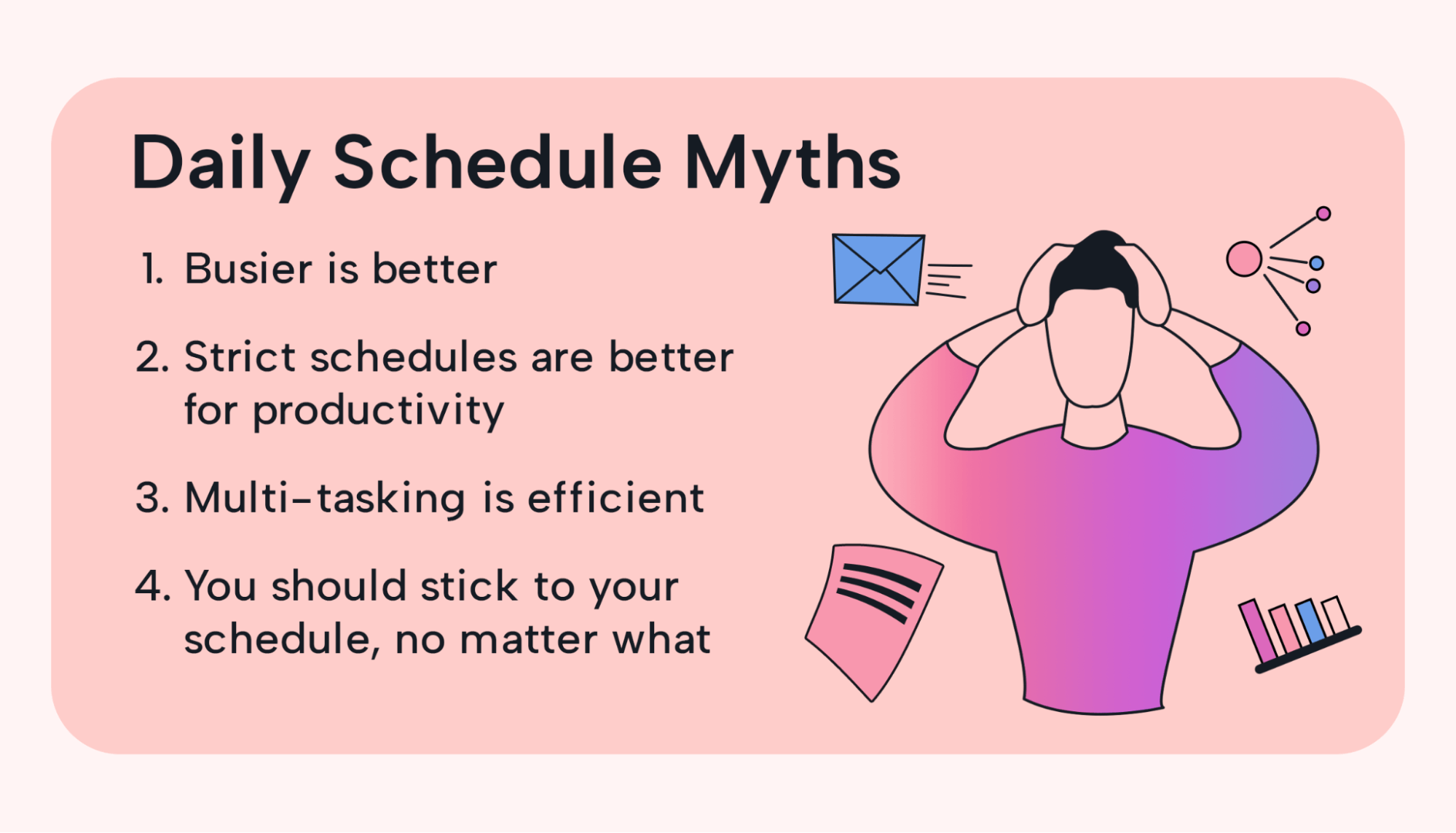 |
Myth 1: Busier is better
One might think that a jam-packed schedule is a sign of productivity and purpose. However, always being busy doesn’t mean you’re effectively managing your time.
Rather than focusing on the quantity of tasks you have on the go at one time, it’s far more valuable to apply yourself to quality uses of time. Overloading yourself can mean missing out on meaningful activities or distracting yourself from your priorities.
Myth 2: Strict schedules are better for productivity
While discipline is essential to achieving your goals, an overly rigid schedule doesn’t improve your productivity.
In fact, it can lead to the following:
- Burnout
- A sense of failure
- Decreased motivation
Myth 3: Multitasking is efficient
It’s a common belief that the more you multitask, the more efficient you are.
However, research consistently shows that when we multitask, we’re not really multitasking. Instead, we’re just switching back and forth between tasks. And that can take energy away from both tasks, making us less productive.
Instead of dividing your attention, focus on one task at a time to help ensure greater accuracy and efficiency.
Automated scheduling and schedule templates: Do they really help?
Let’s now discuss the growth of scheduling methods and tools to help you get a better grasp of whether they really do improve your productivity.
The evolution of scheduling methods
Gone are the days when schedules were scribbled on scrap paper. Scheduling methods have witnessed transformative change.
Manual, cumbersome systems have given way to intricate digital platforms that can drive efficiency and organization in new ways.
As this evolution continues, as it is destined to with the arrival of AI tools and machine learning, the art of scheduling will only grow more intuitive and effective.
The rise of automated scheduling tools
Automated scheduling tools dominate today’s time management landscape — and for good reason, since they:
- Drastically reduce the need for manual entries
- Streamline the scheduling process
- Reduce the likelihood of human error
You can tailor these tools according to your personal or business preferences. Additionally, they integrate into other digital platforms, creating a unified suite of tools.
Key features such as auto-rescheduling and conflict resolution empower users to handle scheduling mishaps with unprecedented ease.
Benefits of using schedule templates
Schedule templates aren’t as intricate as automation tools, but they have their unique place.
They offer a foundation or structure that imparts consistency and uniformity, especially for repetitive tasks or routine events.
However, their true strength lies in their adaptability. Templates can be adjusted based on changing requirements. They’re also easy to replicate and modify without starting from scratch.
Transform your schedule with Motion
We hope you now feel ready to take your daily schedule to new heights.
Crafting the ideal daily schedule requires a blend of strategy, self-awareness, and the right tools.
For those in search of the perfect app to elevate their scheduling, Motion’s powerful AI software is a great choice.
With its intuitive design and cutting-edge features, Motion not only simplifies the scheduling process but also helps you create a schedule tailored to your needs.
If you’re ready to take control of your time, try Motion for free today!

